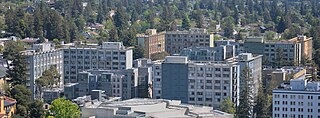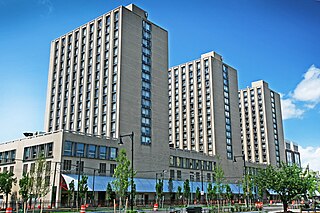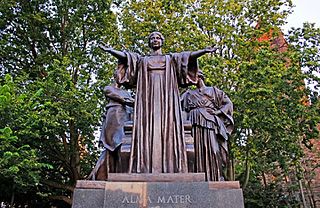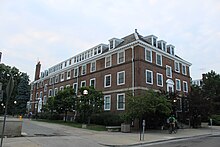
Keene State College is a public liberal arts college in Keene, New Hampshire. It is part of the University System of New Hampshire. Founded in 1909 as a teacher's college, Keene State College had 3,104 students enrolled for credit as of fall 2021.

Aurora University (AU) is a private university in Aurora, Illinois. In addition to its main campus, AU offers programs online at its George Williams College campus in Williams Bay, Wisconsin as well as its Woodstock Center in downtown Woodstock, Illinois. Approximately 6,200 students are enrolled in bachelor's, master's, and doctoral degree programs at Aurora University.

Housing at the University of California, Berkeley, includes student housing facilities run by the office of Residential and Student Service Programs (RSSP). Housing is also offered by off-campus entities such as fraternities and sororities and the Berkeley Student Cooperative (BSC).

The Boston University housing system is the 2nd-largest of any private university in the United States, with 76% of the undergraduate population living on campus. On-campus housing at BU is an unusually diverse melange, ranging from individual 19th-century brownstone town houses and apartment buildings acquired by the school to large-scale high-rises built in the 60s and 2000s.

West Campus is a residential section of Cornell University's Ithaca, New York campus located west of Libe Slope and between the Fall Creek gorge and the Cascadilla gorge. It now primarily houses transfer students, second year students, and upperclassmen.
The main campus of Virginia Tech is located in Blacksburg, Virginia; the central campus is roughly bordered by Prices Fork Road to the northwest, Plantation Road to the west, Main Street to the east, and U.S. Route 460 bypass to the south, although it also has several thousand acres beyond the central campus. The Virginia Tech campus consists of 130 buildings on approximately 2,600 acres (11 km2). It was the site of the Draper's Meadow massacre in 1755 during the French and Indian War.

The University of Illinois Urbana-Champaign is an academic research institution located in Urbana, Illinois and the flagship campus of the University of Illinois System. Since its founding in 1867, it has resided and expanded between the twin cities of Champaign and Urbana.

Housing at the Massachusetts Institute of Technology (MIT) consists of eleven undergraduate dormitories and nine graduate dorms. All undergraduate students are required to live in an MIT residence during their first year of study. Undergraduate dorms are usually divided into suites or floors, and usually have Graduate Resident Assistants (GRA), graduate students living among the undergraduates who help support student morale and social activities. Many MIT undergraduate dorms are known for their distinctive student cultures and traditions.

Litchfield Towers, commonly referred to on campus as "Towers", is a complex of residence halls at the University of Pittsburgh's main campus in the Oakland neighborhood of Pittsburgh, Pennsylvania. Litchfield Towers is both the largest and tallest residence hall at the University of Pittsburgh, housing approximately 1,850 students.
Michigan State University Housing is a large and complex network of housing for students and faculty of Michigan State University. Most of the housing is in the form of residence halls on the school's campus, but there are also university apartments, fraternity and sorority housing, and free-standing housing for grad students, faculty and staff.

Schenley Quadrangle is a cluster of University of Pittsburgh ("Pitt") residence halls that is a Pittsburgh History and Landmarks Foundation Historic Landmark and are contributing properties to the Schenley Farms National Historic District in Pittsburgh, Pennsylvania, United States.

Housing at the University of Chicago includes seven residence halls that are divided into 48 houses. Each house has an average of 70 students. Freshmen and sophomores must live on-campus. Limited on-campus housing is available to juniors and seniors. The university operates 28 apartment buildings near campus for graduate students.
Housing at the University of Georgia is managed by the Department of University Housing. On campus housing for undergraduate students is divided into nine communities, and for graduate students into three communities.
Since the founding, Stanford University has provided on-campus housing for students. Today, all undergraduate students, most graduate students, and many graduate employees use campus housing. While not all graduate students are eligible for campus or subsidized off-campus housing, of those that are, only 64% are able to take advantage of this opportunity due to the limited housing stock. Student Housing at Stanford is currently part of Residential & Dining Enterprises, an in-house standalone vendor within the Stanford affiliated network of businesses.

Fifteen percent of University of Houston students live on campus. UH has several on campus dormitories: Moody Towers, The Quads, Cougar Village I, Cougar Village II, Cougar Place, and University Lofts. UH also has partnerships with three private complexes, Bayou Oaks, Cullen Oaks, and Cambridge Oaks.

Harris Dining Hall – also known simply as Harris Hall- was named after Andrew Lintner Harris and was one of the many dining facilities located on the campus at Miami University in Oxford, Ohio. Since 1961, it was the main all-you-can-eat dining hall for undergraduate students who live on the southern side of the campus. The dining hall was closed after the spring semester of the 2016/2017 school year and it is unknown whether it will reopen. Harris was designed like most other buildings on campus in red brick and with a Georgian Revival architectural style.
Stony Brook University is the largest residential campus in the State University of New York system, with approximately 54.5% of its students living on campus. Housing at Stony Brook is issued and controlled by Stony Brook University Campus Residences, which provides 9,445 spaces in its 11 corridor style buildings, 19 suite style buildings, and 23 apartment style buildings to Undergraduate students, Graduate students, and students' families. The large majority of on-campus housing is provided to students on the university's west campus, but housing is available to those on east campus, and for Stony Brook Southampton students.

West Campus is part of Duke University's campus in Durham, North Carolina. West Campus, along with East Campus, make up most of Duke's main campus. The campus follows the Collegiate Gothic architecture style, inspired by the mid-18th century Gothic Revival style, making it distinct from East Campus. This was in a similar set-up as Cornell University's West Campus built a decade prior.

The main campus of Temple University is in North Philadelphia about 1.5 miles (2.4 km) north of Center City. It occupies 118 acres (48 ha); an estimated 12,626 students live on or near it. Events for students and the public include concerts, performances, clubs, exhibits and lectures.

































